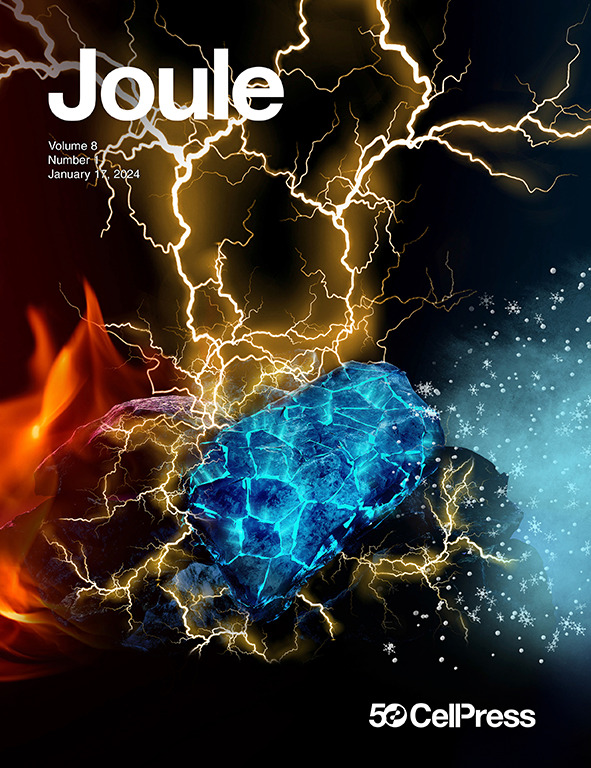高效倒置钙钛矿太阳能电池的厚度不敏感聚合物空穴传输层
IF 35.4
1区 材料科学
Q1 CHEMISTRY, PHYSICAL
引用次数: 0
摘要
近年来,在空穴传输层(HTLs)的帮助下,倒置钙钛矿太阳能电池(PSCs)得到了迅速的发展,特别是自组装单层(SAMs)。然而,目前的器件性能很大程度上取决于HTL厚度,HTL厚度应严格控制在~ 5nm,而10nm的SAM HTL将导致严重的效率损失。在这里,我们报道了一种通过聚[3-(4-羧基丁基)噻吩](P3CT)与1,3,5-三(溴乙基)苯(TBB)的p掺杂制备的厚度不敏感聚合物HTL (P3CT-TBB)。TBB可以从P3CT中的噻吩链中吸出电子,促进P3CT的p掺杂。与对照P3CT相比,掺杂P3CT- tbb的薄膜电导率提高了约10倍。结果表明,在无厚度敏感性的情况下,基于P3CT-TBB的倒置PSCs的效率最高,为26%,而在超过60 nm的P3CT-TBB的PSCs中,效率仍为24%。此外,由于改进了孔提取,器件稳定性也得到了改善,在iso - l -2协议(65°C)下最大功率点(MPP)跟踪1200小时后,保持了初始效率的约90%。本文章由计算机程序翻译,如有差异,请以英文原文为准。


Thickness-insensitive polymeric hole-transporting layer for efficient inverted perovskite solar cells
Recently, inverted perovskite solar cells (PSCs) have been developed rapidly with the assistance of hole-transporting layers (HTLs), especially self-assembled monolayers (SAMs). However, present device performance strongly depends on HTL thickness, which should be strictly controlled to ∼5 nm, and >10 nm SAM HTL will induce severe efficiency loss. Here, we report a thickness-insensitive polymeric HTL (P3CT-TBB) through poly[3-(4-carboxylbutyl) thiophene] (P3CT) p-doping with 1,3,5-tris(bromomethyl)benzene (TBB). TBB can withdraw electrons from the thiophene chain in P3CT to promote its p-doping. The doped P3CT-TBB exhibits a ∼10-fold increase in film conductivity in comparison with control P3CT. As a result, P3CT-TBB-based inverted PSCs show the highest efficiency of >26% without thickness sensitiveness, and >24% efficiency remains in PSCs with over 60 nm P3CT-TBB. Besides, due to the improved hole extraction, device stability is also improved, retaining ∼90% of initial efficiency after maximum power point (MPP) tracking for 1,200 h under the ISOS-L-2 protocol (65°C).
求助全文
通过发布文献求助,成功后即可免费获取论文全文。
去求助
来源期刊

Joule
Energy-General Energy
CiteScore
53.10
自引率
2.00%
发文量
198
期刊介绍:
Joule is a sister journal to Cell that focuses on research, analysis, and ideas related to sustainable energy. It aims to address the global challenge of the need for more sustainable energy solutions. Joule is a forward-looking journal that bridges disciplines and scales of energy research. It connects researchers and analysts working on scientific, technical, economic, policy, and social challenges related to sustainable energy. The journal covers a wide range of energy research, from fundamental laboratory studies on energy conversion and storage to global-level analysis. Joule aims to highlight and amplify the implications, challenges, and opportunities of novel energy research for different groups in the field.
 求助内容:
求助内容: 应助结果提醒方式:
应助结果提醒方式:


